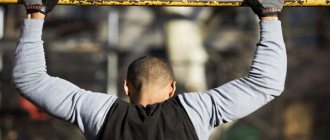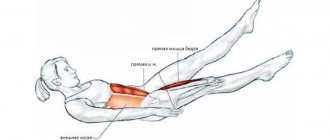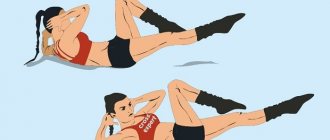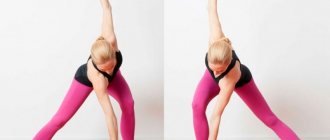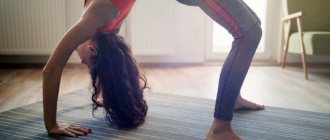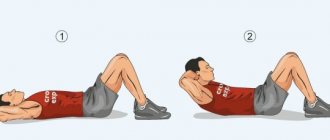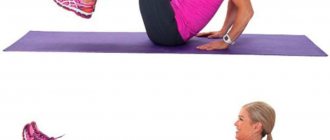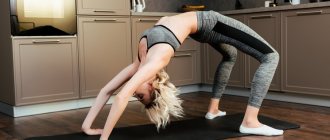The fold or simultaneous twist is a popular gymnastic exercise for developing the rectus abdominis muscle. It is isolating in nature and imitates the movement of simultaneously lifting both legs and body, which is quite rare in everyday life. The fold is done both in fitness and in crossfit, gymnastics, and dancing. The movement is used quite rarely in powerlifting and weightlifting, this is due to the specifics of load distribution and the inability to ensure progression of working weights in movement. We will look at the classic version of twisting on the floor, from a lying position
Execution technique
Initial position
- The exercise is performed on the floor, lying on a mat;
- It is necessary to lie down so that you can gently stretch your spine and press your lower back to the floor as much as possible;
- The athlete lies on the mat; if there is discomfort in the lumbar region, it is permissible to place the hands under the buttocks, with the backs of the palms facing up;
- At the start, the abdomen needs to be pulled inward a little to ensure rigidity;
- The exercise is performed while exhaling.
Movement
- The lifting should begin while exhaling, the athlete simultaneously stretches his legs towards the body, and the body towards his legs;
- The movement is performed with straight legs and a twisted body;
- Resembles hip flexion;
- Exhale with effort, while inhaling the athlete lowers to the floor;
- A lighter version of the fold is performed with bending the legs at the knee joints and bringing the hips towards the stomach;
- Another easier option is for the athlete to place his arms bent at the elbow joints behind his back.
The fold is an abdominal exercise. Technique + error analysis.
Attention
- The exercise is a twisting exercise, the back should not be straight, the goal is to bring the lower ribs to the pelvic bones;
- Lifting your legs too high is wrong. The main movement is performed by the body, and not by the legs;
- A jerking style of execution is not allowed; you should work smoothly and slowly, raise your legs and body calmly;
- There is no need to push the anterior abdominal wall forward;
- It is not recommended to push your chin forward;
- You should bend your legs slightly at the knees, but not to a right angle, unless you want to make the movement easier. You can lower them completely to the floor only if you do not feel discomfort in the lower back.
Pelvic lift for lower abs
In the cycle there are tasks that involve the muscles of the entire abdomen, but it is the muscles of the lower abs that are maximally tense.
Exercise 10: classic pelvic lift
- Lie on your back, stretch your arms along your body, you can spread them a little for support;
- Raise your feet and bend your knees at the same time so that they become parallel to the floor;
- Bring your knees toward your chin to lift your pelvis off the floor;
- Return to starting position;
- Repeat the task 20 times.
Exercise 11: Bent Leg Hip Raise
This task is more difficult. If you are a beginner and cannot yet perform the previous exercise, you can exclude this task for now.
- Lying on your back, place your arms along your body, spreading them slightly;
- Bend your legs at the knees, place one of the heels on the opposite leg;
- In this position, try to raise your knees to your chest while simultaneously lifting your pelvis off the floor;
- Return to the starting position and repeat 15 times;
- Then switch legs and repeat the same number of times.
Exercise 12: moving pelvic lift
Another difficult exercise for the lower abs, which can be mastered only after training.
- Lying on your back, keep your arms along your body;
- Raise your feet up above the floor, knees can be slightly bent;
- Raise your pelvis in this position, leaning on your hands, and when you lower your pelvis back, try to move it to the side;
- Lift your pelvis back up and now lower it to the other side.
This exercise is good for working out the lower abs and side muscles.
Recommendations
- This exercise teaches you to concentrate on the moment of peak muscle contraction. If you don't feel the twisting, you should start with a simpler option;
- The movement should be performed smoothly not only during the ascent phase, but also during the lowering phase. It is worth controlling the lowering so that the muscles do not immediately relax completely;
- It is incorrect to perform the exercise by pushing the head with your hands. Concentrate on working your abs;
- The legs should remain slightly bent at the knees; only very flexible people can afford absolutely straight legs like those of athletes in rhythmic gymnastics and the fitness category;
- It makes sense to perform the movement on a soft and thick rubber mat; yoga mats and mats will not help here;
- It is advisable to wear high-waisted sportswear and non-slip T-shirts to avoid skin damage
Plank
This is the most famous static abdominal exercise. By the way, the bar trains not only the abdominal muscles, but also many other muscles of the whole body. The plank perfectly develops endurance and perfectly dries the body (gets rid of extra pounds).
Front bar
Execution: Get on all fours, and then take a plank position, standing on your elbows.
It is necessary to hold in this position for 30 seconds or more. Typically no more than 2 minutes is recommended.
Keep your body straight and pay attention to the sensations in your lower back. If tension appears in the plank while doing the plank, stop doing the plank for a while. You first need correction of lumbar lordosis.
The plank can be performed in 3 approaches of 30-120 seconds.
Execution options
- “Half fold” - lifting the legs with lifting the body from a fixed position, in which the forearms are on the floor, and the top of the rectus abdominis muscle is brought up only statically;
- Fold on an inclined bench - on the contrary, the body is lifted from a position in which it is tilted back; Fold with rubber shock absorber, additional resistance of the shock absorber when lowering allows you to load the muscles more;
- A curl with dumbbells or other weights is one way to increase the load. It is recommended to take the dumbbells in your hands rather than hang the weight on your feet;
- Fold on a gymnastics bench. This option differs in that the athlete performs an imitation of the movement on the floor, sitting on the pelvis on a bench. He lowers his legs to the floor, and his body too, to achieve a full stretch of the abs, and then rises up again.
How to do the fold exercise correctly
Muscle load
The fold intensively works all the abdominal muscles, especially the rectus abdominis (its lower and upper parts). Thus, this one exercise replaces classic crunches, which load the upper abs, and lying leg raises (or reverse crunches), which emphasize the load on the lower abdominal muscles.
The exercise also uses the oblique abdominal muscles - they always work in conjunction with the rectus abdominis. However, the load on the oblique muscles in this exercise will not be as significant as, say, in oblique or lateral crunches.
The hip flexors and quadriceps (quadriceps) work in an additive manner.
Analysis of the exercise
What muscles work
Main muscles:
- The rectus abdominis muscle allows you to twist;
- Obliques – turning the body;
- Transverse – abdominal retraction
Accessory muscles:
- Additionally, the quadriceps, iliacus muscles, forearms and back work.
pros
- Available to those who do not have any equipment and who practice at home;
- Simple enough to learn on your own, does not require much technical skill;
- Allows progression when crunches are easy;
- Helps to get strong abs, especially for team sports, running, and other applied disciplines;
- Helps diversify training
Minuses
- A fairly complex exercise for people with pelvic displacement and hyperlordosis;
- Does not allow for significant progression if the athlete is involved in strength sports;
- May be ineffective if the athlete has overdeveloped quadriceps;
- Does not give the desired effect if the technique is careless;
- Not recommended for people with back injuries;
- Cannot be performed with diastasis of the rectus abdominis muscle
Preparing for the exercise
First you need to understand how to perform any twisting. Stand straight, point your lower ribs towards your pelvic bones, and twist completely. You will feel the tension in the rectus abdominis muscle exactly as needed. Twisting in this regard will help you understand how to work your abdominal muscles.
Before the fold, it is better to do a general aerobic warm-up if you are not going to do a full set of strength exercises yet, or just start it at the end of your regular workout.
Sometimes it is recommended to do several sets of simple straight abdominal crunches as a warm-up.
Proper execution
- The most direct analogy here is with classic crunches. The body should twist with the lower ribs towards the pelvic bones, and not just flexion and extension at the hip joints;
- You should not pull your head forward with your hands and perform the exercise due to this;
- It will be better if you learn to do the exercise with your legs as straight as possible and do not bend your knees too much;
- Beginners can do bringing the knees to the chest, but this is not quite a fold, but a lighter version of the exercise;
- The movement is based on twisting, and not on lifting the legs, although the movement of the body and legs should be simultaneous;
- You should actively engage the transverse abdominal muscle and pull your stomach inward so that the twisting is as complete as possible;
- The exercise must be performed by statically straining the abdominal muscle, and not twisting at random, and making movement solely due to inertia. The exercise is not performed for a number of repetitions;
- Touching your feet with your palms helps you twist as much as possible in this movement, but this technique can be missed if you can’t fully reach your feet without turning on the force of inertia
- The legs need to be extended, but a slight angle in the knee will protect the popliteal ligaments from injury;
- At the point of maximum twisting, the athlete sits, as it were, on his buttocks, and remains in this position for as long as possible;
- Lifting should be done by contracting the abdominal muscles, and not by doing a set of swinging from a lying position. If there is swinging, the abs are still too weak to work out in this position, and you should look for another load option, a simpler exercise;
- You need to remember the rhythm of breathing, exhale with effort, inhale with lowering. Holding your breath while performing abdominal exercises is not recommended.
V-UPS (The best ABS exercise)
Errors
- Lifting with fully straightened legs and pointed toes;
- Flat back, no twisting phase;
- Work due to inertia alone;
- Incomplete amplitude - the athlete does not reach the buttocks and does not twist, but simply tries to lift his legs and body;
- Legs fully bent at the knees
Efficiency Tips
- Twisting can be made more difficult by holding a small weight in your hands. Yes, then it will not compare with crunches on an incline bench, or the “prayer” exercise in terms of resistance, but it will increase the load;
- If you do not completely lay your shoulder blades on the floor and do not completely lower your pelvis, the exercise will be more effective, since then the muscle will constantly remain in a state of static tension;
- The negative phase of the exercise can be slowed down, and thereby improve the quality of muscle contraction;
- The movement can and should be performed after preliminary fatigue of the leg muscles; this will help not to “work” with the quadriceps. In this regard, combining leg training with a “fold” at the end will have a positive effect
Contraindications
Despite the many positive effects on the body, there are the following contraindications for stretching:
serious spinal injuries; too frequent lower back pain; inflammation of the joints (especially the hip); severe bruises; fractures; hypertension; hernias; osteoporosis;
high blood pressure; pregnancy (exercises can be allowed, but with caution and under the supervision of a trainer for pregnant women).
Read also: Why do people do evil?
Contraindications also include discomfort during stretching. If sharp pain occurs during training, or crunching is often heard, then you need to stop exercising. You should also not stretch if you have recently healed fractures or injuries without consulting a surgeon.
Inclusion in the program
The inclusion of a fold depends on how prepared the athlete is and what his goal is. For those who develop endurance for athletics or cyclic sports, it is recommended to perform the fold in a multi-repetition mode, increasing the number of repetitions to the maximum possible.
For those who exercise simply for health and beauty, we can advise you to do the exercise in a mode that is comfortable for yourself, and not to do too much repetitive work.
The movement can be done as part of a separate ab workout if you need it, or as an exercise at the end of a regular strength training session. The fold is extremely rarely done as a warm-up exercise.
You can do a fold, alternating it with other exercises, or replacing more familiar abdominal movements with it.
If the goal is weight loss
If you want to not only work out your muscles, but also lose weight, be sure to add several hours of aerobics per week to your strength training. This way, you will achieve impressive results faster. Your waist will decrease in volume, and your stomach will noticeably tighten.
In addition to physical activity, weight loss requires adherence to the principles of proper nutrition. This doesn't mean you need to go on a strict diet. Eat a varied diet, choose minimally processed foods, and control the amount of calories you put into your body. To lose weight, you need to consume a little less than you expend.
In the future, to maintain the results achieved, you will need to train several times a week, and consider proper nutrition not as a temporary measure, but as your way of life.
Variations of “Folds” for a variety of fitness training
To diversify your fitness activities, you can include various variations of “Folds”, which differ in the complexity of the technique. The most popular implementation options include the following:
- Dynamic "Fold".
Take a starting position while sitting on the floor, raise your arms and stretch them with the top of your head up, inhaling deeply at this moment. Next in the exercise, you need to put your hands on your hips and tilt your straight body forward, first pressing your lower abdomen to the upper thighs, and then, making shallow springy bends, gradually lower your body towards your legs. The number of such bends should be at least 30. This version of the “Fold” is well suited for warming up before performing other, more complex elements of fitness training.
- Reverse "Fold".
Sit on the floor, bend your lower limbs, clasping your feet with your palms and pressing your stomach and chest to your thighs. Exhaling, begin to slowly straighten your knees, stretching your legs forward. This exercise should be performed as smoothly as possible, allowing the muscles to gradually get used to the load.
- “Fold” with socks pulled away from the body.
This implementation option is considered the easiest. It does not load the popliteal fossa, so it is ideal for beginners to become familiar with the correct technique of this exercise. To perform such a “Fold,” you need to sit on the floor, keeping your back straight, raise your arms up, stretch your lower limbs forward, pointing your toes away from you, and tilt your body, pressing your lower abdomen to your groin and pushing your body forward.
- “Fold” with the toes pointing towards the body.
All actions in this exercise are identical to the classic version of the “Fold” stretching exercise. The only difference is the direction of the toes. In this case, they should be facing the body. Thanks to this position, there is a fairly intense load on the hamstring ligaments and tendons, which manifests itself in a feeling of stretching in this part of the body.
- "Fold" with a partner.
To perform it, you need the help of an assistant, who should be near the feet of the person performing the exercise and pull him slightly towards himself so that the trainee’s chest protrudes further than his knees.
- "Fold" with support.
This advanced option is recommended to be included in fitness training when a person can freely rest his body on his lower limbs. To perform such a “Fold,” you need to place cubes or bolsters under the heels, while the assistant should lightly press on the trainee’s back, thus further increasing the load.
How to train
It is important not to overdo it when performing such exercises. By training intensively, devoting only the abs for 60 minutes. a day or more, you are thereby doing excessive massage for the internal organs, and this can lead to bad consequences. The ideal option is 15-20, regardless of the time of other training. For beginners, it is generally advisable to start with a few of the easiest movements with a minimum of repetitions of two sets. You can not exercise every day, but regularly, at least every other day. After a week, if you feel the need to increase the load, add more load.
Abdominal exercises at home are the same for everyone. But representatives of different sexes also set different goals. The cubes at the very top of the abdomen look even more or less acceptable. But if lower abs are also visible on a woman’s stomach, this is a clear sign of excessive training. Dried, maximally sculpted abs, ideal for the male body, not only do not look very attractive on women, they also threaten serious consequences: metabolic processes may be disrupted, which is fraught with problems with the reproductive system.
Where to begin?
Before you think about how to do a kip-up, you should learn how to do a bridge. Learn to bridge from your back and do bridge push-ups. Some consider this point optional and begin to study the kip-up without any stretching. But not all people are able to do this exercise, without acquiring the skill of bridge push-ups and other things. You must understand how you should arch correctly in the kip-up movement. Therefore, in order to avoid unnecessary injuries, troubles, and generally simplify your life, start with this.
Interesting Facts
Use different types of crunches in your workouts to achieve good results as quickly as possible.
American scientists from the biomechanics laboratory of the University of San Diego conducted research on exercises for working out the abs. They used an electromyograph to evaluate the load the muscles received during exercise.
In their Top 7 exercises, crunches with arms outstretched were in sixth place, crunches with legs raised were in fourth place, and crunches on a fitball were in third place.
At the same time, the most effective exercises were recognized as hanging leg raises and cycling, which took second and first places, respectively.
